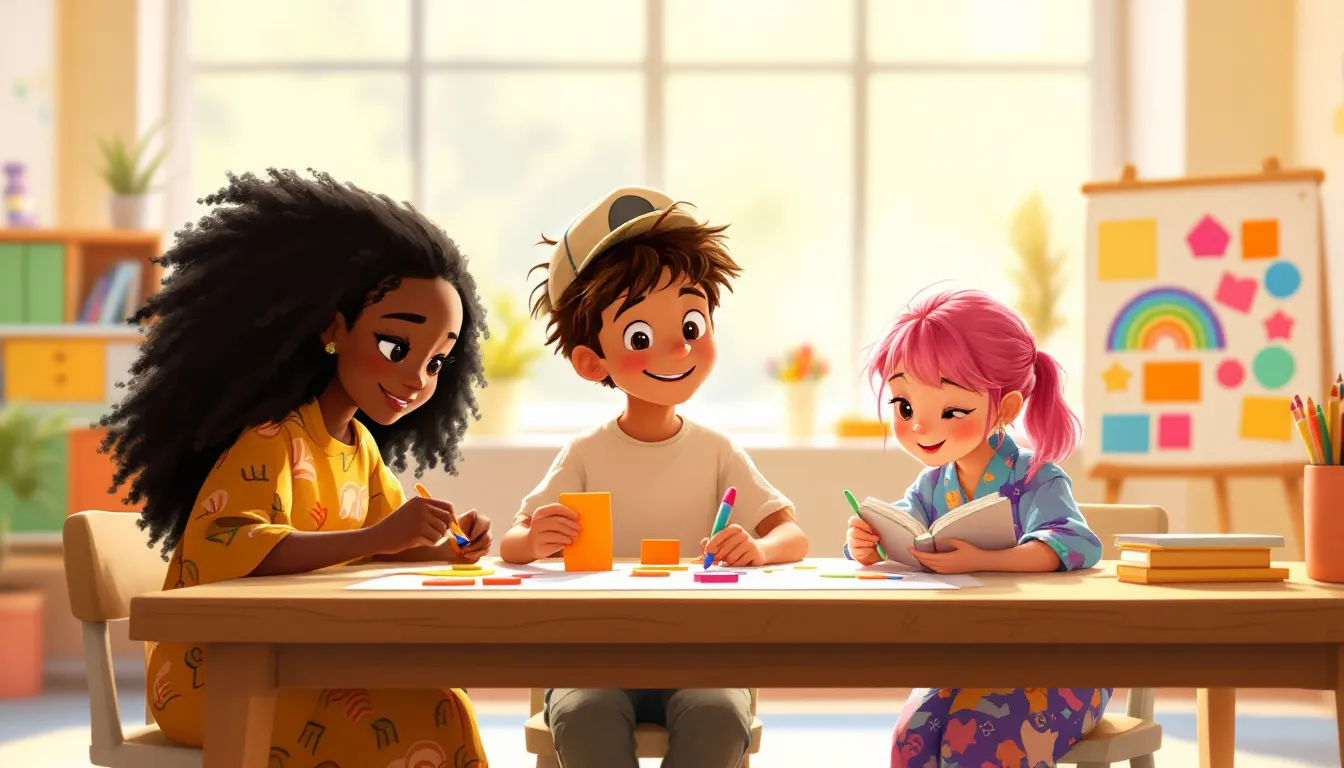Finding engaging writing prompts for second graders can be a challenge.
This article provides a comprehensive set of imaginative story starters that will inspire young writers to flex their creative muscles.
You'll discover seasonally-themed ideas, character and plot development tips, visual writing cues, first sentence wonders, templates and frames, question prompts, peer collaboration strategies, and more for crafting narratives that capture attention and imagination.
Writing prompts can be a fun for 2nd grade students
Writing prompts can be a fun and engaging way to help second graders develop important narrative skills like character development and plot structure. At this age, creative writing also builds vocabulary, imagination, and self-expression.
Here are some of the key benefits of using writing prompts with second graders:
- Helps them practice essential narrative writing skills they will need in later grades
- Allows them to use their creativity and imagination
- Gives them an outlet to express opinions and ideas
- Introduces them to age-appropriate topics and themes to write about
- Provides a playful way to develop writing abilities through storytelling
When choosing prompts, it's important to select topics that will resonate with second graders' experiences and capture their interest. The prompts below offer creative springboards to get their stories started.
What should a 2nd grader be able to write?
Second graders are developing their writing skills and learning how to organize their thoughts. Here are some things a typical second grader should be able to write:
Beginning, Middle, and End
- They can structure their writing to have a clear beginning, middle, and end. This shows they understand basic plot structure.
- The beginning introduces the topic, characters, and setting. The middle develops the events and conflict. The end resolves the conflict and concludes the story.
Simple Essay Elements
- Second graders can write a simple essay with basic elements:
- A title
- An introductory sentence stating the main topic
- Supporting detail sentences with examples
- A concluding sentence to summarize key ideas
Supporting Details
- They can provide relevant details, descriptions, and examples to support the main topic or story events. This adds interest and showcases their vocabulary.
Concluding Sentence
- A concluding sentence wraps up the writing and reinforces the main point. This demonstrates understanding of main ideas versus supporting details.
In summary, second grade writing aims to organize ideas logically, provide descriptive details, and conclude with a summary statement. With practice in these areas, students build narrative skills to write cohesive stories or informational pieces. The key is structure and elaboration.
What is a fun journal prompt for 2nd grade?
Here are some fun journal prompt ideas to get your 2nd graders writing creatively:
General prompts
- Write about a time when you and a friend had a problem. What was the problem? How did you solve it?
- Write about a favorite birthday party you have had or went to. What made it so fun?
- Write about when you learned how to do something new. What did you learn? Who taught you? How did it make you feel?
These open-ended prompts allow students to write about their own experiences in a personal way. They encourage students to tell a story and describe events in detail. The prompts are designed to inspire narrative writing skills like character development, setting descriptions, sequencing events, and expressing opinions.
When students write about their own lives, it makes the writing more engaging and meaningful for them. The topics are also age-appropriate, tapping into common childhood experiences like birthday parties, learning new skills, and navigating friendships.
What are some creative writing prompts?
Here are some fun and imaginative story starter prompts to get your second graders excited about creative writing:
FREE PROMPTS FOR EVERYONE
- Write about the first conversation you had today. What did you talk about? Who was it with? How did the conversation make you feel?
- Describe your evening routine in vivid detail, step-by-step. What do you do before bedtime to get ready? Brush your teeth? Read a book?
- Imagine you become best friends with a character from your favorite book. Write about what a day spent together would be like. What would you do for fun? Where would you go?
These open-ended prompts encourage students to tap into their imagination. They allow kids to express opinions, practice narrative writing skills like character development and plot structure, and explore age-appropriate topics in a creative way.
Use visual prompts with pictures to spark additional story ideas. When students have an image to reference, they can better describe scenes and build imaginative worlds for their characters.
Scaffold writing development with graphic organizers. Provide second graders with story maps and plotting worksheets to help them structure a basic narrative. This allows kids to translate imaginative ideas into organized stories with a beginning, middle and end.
Focus on the writing process, not just the final product. Have students brainstorm ideas, outline drafts, revise their work and share with peers. This develops essential skills for improving creative writing abilities at this grade level.
How can I make my 2nd grade writing fun?
Here are some fun and engaging writing ideas to try at home with your 2nd grader:
Write for a reason
Help your child understand that we write for specific purposes and audiences. Have them write a letter to a family member, create their own storybook, or write a review of a movie they recently watched. Giving their writing real-world applications will make it more meaningful.
Make a journal jar
A journal doesn't have to just be a diary. Fill a jar with fun writing prompts like "What is your favorite ice cream flavor and why?" or "What would you do if you were invisible for a day?". Have your child pull one out each day and write about it in their journal.
Play "tell me how"
Pick an everyday activity like making a peanut butter and jelly sandwich. Have your child write out the steps to teach someone else how to do it.
Play writing games
Games like story cubes or once upon a time provide story starters and creative inspiration to get the writing flowing.
Write letters
Have your child write letters to family members and mail them. This gives their writing an authentic audience.
Write family stories
Interview grandparents and other family members about what life was like when they were kids. Turn these memories into short stories.
The key is providing real-world writing opportunities that feel purposeful. With fun ideas like these, your 2nd grader's writing skills will blossom!
Crafting Creative Writing Topics for Grade 2
Age-appropriate and engaging writing prompts are key to sparking second graders' interest in creative writing. Selecting topics that resonate with 7-8 year olds' experiences helps them connect personally with their writing.
Incorporating Seasonal Themes
Tying writing topics to seasons and holidays like summer break and Halloween helps make writing fun. For example:
- What are your plans for summer vacation? Where will you go and what will you do?
- Imagine you could have any magical power. What would it be and how would you use it?
Imaginative Writing Prompts for 2nd Grade
Fantastical scenarios stretch young imaginations. Fun imaginative prompts include:
- You wake up one morning with a superpower. What is your superpower and how do you use it?
- You find a magic wand that can make three of your wishes come true. What do you wish for?
Expressing Opinions in Writing
Second graders have strong opinions worth sharing! Opinion-based prompts help them articulate their thoughts:
- What is your favorite season? Give three reasons why.
- Is it better to eat vegetables or candy? Explain your choice.
Everyday Adventures
Writing prompts based on daily life experiences tap into background knowledge. Relatable ideas include:
- Write about your favorite family trip or vacation. Where did you go and what did you do?
- If you could be the teacher tomorrow, what would you teach the class? What fun activities would you plan?
sbb-itb-bb2be89
Developing Plot Structure and Character
Writing prompts can help guide second graders to build key narrative writing skills like plot structure and character development. Here are some tips:
Initiating a Compelling Plot
When creating a writing prompt, it's helpful to include an interesting scenario or event to hook the reader and initiate the plot. For example:
- You wake up one morning to find your room filled with balloons. What happens next?
- Your teacher tells the class that you will have a surprise substitute teacher tomorrow. Who is it?
Encourage students to think about the 5 W's in their story:
- Who are the main characters?
- What is the setting?
- What happens first to set things in motion?
- What events build up to the climax?
- How is the conflict resolved in the end?
Creating Dynamic Characters
Prompt students to develop characters by asking:
- What does your character look like?
- How do they behave? Are they shy or adventurous?
- What are their likes/dislikes? Dreams or fears?
Encourage using descriptive words like "athletic", "messy hair", "imaginative", etc. Suggest including dialogue to reveal personality.
Navigating the Middle and End
Explain that the middle builds up to the climax - the most exciting or important moment. The end ties up loose ends and shows how the conflict is resolved.
Ask questions to push the story forward:
- What challenges arise as your character pursues their goal?
- How do they overcome the obstacles?
- How does the story end? Is the conflict resolved?
Integrating Obstacles and Resolutions
Prompt students to create obstacles appropriate to their story's context. Instead of generic "issues", encourage using vivid details. They can reveal solutions through dialogue, character's thoughts, or actions.
Remind students that an engaging ending resolves the main conflict and ties up loose ends.
Enhancing Stories with Visual Cues
Visual cues like pictures and comics can be powerful storytelling tools for young writers. Integrating visuals into second grade writing prompts helps inspire students' creativity, build vocabulary, and strengthen narrative skills.
2nd Grade Writing Prompts with Pictures
Using pictures in writing prompts captures students' attention and sparks their imagination. When students see an interesting photo, they start picturing who the people are, what they might be thinking or feeling, and what events led up to that moment.
Guiding questions help students interpret the visual details and transform them into a story. For example, show a picture of a girl looking at a freshly baked cake and ask:
- What do you think happened before this photo was taken?
- How might the girl be feeling and why?
- What do you think will happen after this photo?
Open-ended questions allow room for creativity as students develop their own unique stories.
Comic Strip Storytelling
Comic strips intrinsically connect words and pictures to convey narratives visually. Using comic strip templates in writing prompts helps teach second graders how sequence images to tell a logical story.
Students can write stories to align with pre-made comic strip panels. Or they can create their own comic strips scene-by-scene to bring their writing to life visually. This builds understanding of narrative elements like setting, characters, plot and resolution.
Drawing from Personal Photographs
Encourage students to bring their own photos to class as writing inspiration. Photos from family vacations, holidays, and school events often resonate emotionally with children.
Prompt them to study a photo and explain:
- Who is in the picture and how they relate
- What important event is happening
- How it makes them feel and why
Connecting writing topics to students' own lives increases engagement and investment in their stories.
Picture-Based Vocabulary Expansion
Integrating new vocabulary words into writing prompts helps reinforce second graders' language skills. Using related pictures grabs their interest in learning new words and makes their meanings more memorable.
For example, teach terms like "joyful", "proud", "frustrated" etc. Show images depicting each mood, then have students write stories describing the emotions and situations. This way students actively apply new vocabulary instead of just memorizing definitions.
Visual cues powerfully ignite young writers' imaginations and improve literacy abilities. Second grade teachers should incorporate relevant photos, comics, and illustrations to create engaging, effective writing prompts.
Structuring Engaging Story Starters
First Sentence Wonders
Here are some examples of strong opening sentences that capture a reader's attention and set up an imaginative story:
- As I opened the mysterious box left on my doorstep, I wondered if my life would ever be the same again.
- The trees whispered to each other as I tiptoed through the dark forest, trying not to be seen.
- I never expected a simple game of hide-and-seek to lead me to the discovery of a hidden world.
These first lines introduce intriguing premises that make readers curious to find out what happens next. They set up imaginative scenarios that second graders can build on in their own stories.
Story Frames and Templates
Fill-in-the-blank story starters provide helpful structure for young writers. Here are some templates to try:
- One day, [name of character] found [an object] in [a place]. [He/she] decided to [action] with it, but little did [name of character] know what would happen next!
- [Name of character] loved [an activity] more than anything, but when [a problem occurs], [he/she] has to find another way to [resolve the problem].
These frames allow students to invent key details like characters, settings, and plot points. The sentence structure guides them to move the narrative forward.
Question-Based Prompts
Starting a story by asking a compelling question grabs readers' interest right away. For example:
- What if you woke up one morning with a superpower? What would you do?
- If you could talk to animals, which animal would become your best friend?
Having students answer these questions helps them establish an imaginative premise for their stories. The question format gives them a sense of purpose and direction.
Dialogue Openings
Dialogue is another excellent way to begin a narrative. Some examples:
- "I can't believe what I just found!" Tina shouted as she burst into the room.
- "Shhh, did you hear that?" Joey whispered to his sister. Something was rustling in the bushes behind them.
This technique introduces readers to characters immediately while hinting at an exciting development to drive the plot forward.
Implementing Writing Prompts in the Classroom
Creating a Writing Routine
Establishing a consistent writing time allows students to build creative writing skills. Have students journal for 10-15 minutes at the start or end of each day responding to a prompt. Topics could include imagining a day as their favorite animal or superhero. Over time, they will become more comfortable expressing themselves through writing.
Showcasing Student Creativity
Display students' writings on a bulletin board or classroom website so they feel proud sharing their work. Occasionally, have students read aloud their response to a fun prompt for the class. With permission, compile selections into a printed booklet.
Peer Review and Collaboration
Students can swap journals and add to a peer's story, or co-author tales mixing their creative ideas. Also, pair students to give constructive feedback on each other's writing using a simple rubric focusing on ideas, organization and voice.
Incorporating Technology
Some free apps and websites provide age-appropriate writing prompts, and allow students to illustrate and publish their work digitally. These tools boost engagement, and allow easy distribution to parents. However, ensure a balance between technology and traditional writing.
Evaluating Student Progress
Evaluating student progress in creative writing can seem daunting, but using a few key methods makes it manageable and rewarding. Assessing growth over time, rather than just the end product, is essential.
Rubrics for Narrative Skills
Rubrics break down key narrative skills into observable behaviors to evaluate. For second graders, focus on:
- Character development: Can they describe a character's personality traits, emotions, desires? Do characters experience change over the story?
- Plot structure: Are there a clear beginning, middle, and end? Is there a sequence of events with an initiating event, rising action, climax, and resolution?
- Sensory details: Do they use descriptive words related to the five senses - sight, sound, touch, taste, smell?
Share rubrics with students so they understand expectations. Use a 3-point scale to rate mastery.
Journal Reviews
Regularly review each student's writing journal to see their progress over time. Provide encouraging feedback and praise growth in specific skills. Suggest potential areas for improvement they could focus on next.
Writing Portfolios
Compiling multiple writing samples in a portfolio allows evaluation of growth across an entire year. Include a range of works - both prompted and free choice pieces. Portfolios make discussions with parents and students very concrete by showcasing the breadth of creative output.
Parent and Student Conferences
Discuss the student's strengths and stretches with parents and the child themselves. Show growth in skills by comparing early and later writing samples side-by-side. Collaboratively set 1-2 goals for continuing progress. Conferences reinforce growth mindset and accountability.
Conclusion: The Power of Story Starters
Regular use of imaginative writing prompts helps second grade students build essential narrative skills. By providing fun and engaging story starters, teachers give young writers the tools to thrive.
Over time, prompts encourage students to:
- Strengthen creative thinking
- Expand vocabulary
- Build sentence fluency
- Develop story structure
- Practice elements like character and plot
Quality prompts spark ideas and allow creativity to blossom. Students gain confidence in self-expression within a supportive environment.
With continued practice using imaginative prompts, second graders grow as writers. Their stories become more complex and descriptive. Students also learn to apply conventions of print, grammar rules, and punctuation.
In closing, integrating regular story starters into the writing curriculum powerfully impacts young writers. Prompts lay the foundation for blossoming imagination and literacy.


